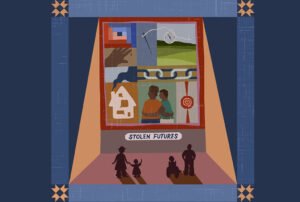
The United States is losing hundreds of thousands of unregulated, unsubsidized “naturally occurring” affordable homes each year to speculative buying, rent hikes, and evictions. Additionally, some 200,000 homes subsidized by the Low-Income Housing Tax Credit (LIHTC) will lose their affordability restrictions in the next five years.
Making matters worse, as millions of Americans struggled to withstand the economic damage of COVID-19, private equity firms expanded into the housing market, in some cases buying entire neighborhoods. Many for-profit landlords also employed algorithmic software to raise rents sky-high in major metro areas. (Effectively, this software helps landlords know what other landlords are doing, thereby coordinating rent increases and greatly reducing tenant bargaining power.)
Most government housing funding is spent on subsidizing mortgages—primarily for the well-to-do.
It’s no wonder that escalating housing costs are a core driver of inflation and rank among Americans’ biggest election concerns in 2024. Yet, housing issues receive little attention on the campaign trail.
Faced with a broken system, more Americans—across urban, suburban, exurban, and rural communities—are rallying around a positive vision for the future, one rooted in social housing systems that ensure housing for all.
Beyond the White Picket Fence
Although the phrase “social housing” might be relatively new in the United States, the demand for housing that meets social needs is not. Civil rights, queer rights, Indigenous sovereignty, environmental justice, and organized labor movements have all long demanded secure, permanently affordable, and decommodified housing.
In the 1930s, as the New Deal took shape, a coalition of labor unions and visionary housing activists formed the Labor Housing Conference. Building on successful experiments in cooperative housing built by labor unions, they pushed for the type of large-scale, universal housing programs germinating during the interwar period in European cities like Vienna. Some of these New Deal successes, like the Harlem River Houses or the nearly 50,000 resident “Co-op City” in the Bronx, are still around today.
However, intervention from real estate interests created a racist two-track housing system of redlining. Underfunded public housing was segregated away from desirable suburban land, where prospective, mostly White homeowners were lifted into the middle class through property ownership. Now, most government housing funding is spent on subsidizing mortgages—primarily for the well-to-do—and residential land is zoned for single-family homes and suburban sprawl.
Since the 1970s, federal funding for housing has dwindled—particularly for public housing, which was demolished and privatized in many cities through programs like HOPE VI. The concurrent erosion of public investment in other social welfare programs over successive Democratic and Republican administrations put additional pressure on private housing markets, which now functions as not just a place to live but a perpetually appreciating asset to be leveraged to pay for healthcare, education, retirement, and other essential costs of living. This, in turn, politically polarized many middle-class property owners, dependent on their home values for stability, to oppose any policy perceived as a threat to property appreciation.
Social housing is not just about providing shelter, but creating high-quality, permanently affordable housing across a range of incomes.
The 2008 crash ripped the promise of homeownership away from millions of families, especially Black and Latine families targeted by Wall Street with predatory subprime mortgage loans. While Wall Street was bailed out, these Americans became lifetime renters. Like other renters, they became perennially unstable, thanks to the advocacy of real estate lobbies who continue to systematically oppose renter protections at every level of government while benefiting from soaring rents.
The as-seen-on-HGTV single-family home with a white picket fence is now less of an American dream than a vicious trap. Yet more than a decade after 2008 and the Wall Street bailouts, policymakers have been slow to acknowledge that the current housing system has failed, let alone entertain the idea that any alternative is possible. The organic growth of local, state, and federal social housing campaigns is the seed of a structural response to this failure.
What Is Social Housing?
Social housing is not just about providing shelter but creating high-quality, permanently affordable housing across a range of incomes that are owned or controlled by a public agency, a nonprofit, or a cooperative of tenants themselves. Resident associations, tenant unions, and surrounding communities play key roles in managing it and, in some cases, developing it.
Social housing is protected from corporate profiteers and backed by sufficient government support to ensure affordability and accessibility for everyone, including those in privately-owned residences who have alternatives to exploitative landlords. It can create secure, well-paying construction and repair jobs and ensure that housing is green, energy-efficient, and more resilient to climate disasters.
Social housing campaigns look different in different communities. It can be public housing tenants fighting for much-needed repairs and green investments in their units, a mobile home park whose residents have bought their housing from a slumlord to run it themselves as a tenant-owned limited-equity cooperative, or a ballot initiative creating a development authority to finance new construction for low- and middle-income tenants at scale, and more. Each campaign reflects its community’s needs, but all share a demand for a housing system that gives residents real stability and control over their future.
Sign up for our free newsletters
Subscribe to NPQ's newsletters to have our top stories delivered directly to your inbox.
By signing up, you agree to our privacy policy and terms of use, and to receive messages from NPQ and our partners.
What We’ve Learned So Far
Over the last two years, PolicyLink has convened grassroots housing, climate, and economic justice organizers across the country. One result of this collaboration is a new report, Building Our Future: Grassroots Reflections on Social Housing, which the two of us helped author, along with several colleagues. Our report outlines vision, strategies, and policy recommendations, many of which we are already pursuing, to win social housing. Among the key findings is the need to ensure that homes are genuinely affordable for those with the least financial means while also supporting middle-class residents struggling with housing costs.
In the San Francisco Bay Area, renters have formed tenant unions, campaigned against mass evictions, and even occupied vacant homes owned by corporate landlords to convert their buildings into community land trusts (CLTs) while organizers pursue municipal and regional ballot initiatives to fund these homes. In Houston, organizers have focused on eviction prevention, access to FEMA funding in the aftermath of Hurricane Harvey, and organized tenants to support local candidates for office who prioritize the housing-insecure, influencing tenant protection policies for subsidized affordable housing.
In the Inland Empire of California, tenants are establishing CLTs to create permanently affordable housing. In Kansas City, the citywide union KC Tenants won a $50 million bond for low-to-moderate-income housing and elected tenants’ rights champions to the City Council.
In Los Angeles, a broad coalition of housing, labor, climate, and interfaith groups went to the ballot and won the United to House LA measure, a “mansion tax” on property sales of over $5 million to fund social housing and homelessness prevention programs. Seattle organizers won big at the ballot to create a municipal social housing developer for new mixed-income developments. Washington, DC, is considering the Green New Deal for Housing Act, which would create publicly owned, permanently affordable green housing with tenant oversight boards, as New York State lawmakers pursue the establishment of a similar Social Housing Development Authority.
In Connecticut, a growing network of tenant unions negotiate directly with landlords for improvements, even demanding the opportunity for tenant acquisition during future property sales. In Hyattsville, MD, organized immigrant renters won compensation and transferred their building’s ownership to a mission-driven landlord.
Ongoing Obstacles
The success of these campaigns is heartening, but this work is not easy. Even the most sympathetic elected official is constantly under pressure when bucking policies preferred by deep-pocketed donors in landlord, realtor, and developer lobbies. Ballot measures require significant funding, coordination, and voter outreach.
The rapidly growing tenant union movement is transforming the home from a site of individual struggle into a collective force for progress.
There is also resistance within the affordable housing community. For example, some developers dependent on the Low-Income Housing Tax Credit to fund subsidized housing have expressed skepticism that funding solutions beyond LIHTC—a scheme devised in 1986—are possible.
Intentional disinvestment in state capacity, especially public housing, has created distrust among some parts of the public that government entities can deliver effective solutions.
Finally, the dream-turned-nightmare of the white picket fence has still convinced many Americans that individual property ownership is the only path to wealth-building and material stability. This sentiment is incentivized by our financial and real estate systems and many of our policymakers, even as climate change is making many suburban and exurban communities uninsurable and unlivable.
The Path Forward
Obstacles to social housing can be overcome by building new political constituencies of tenants, working in coalitions, and encouraging a diversity of social housing tactics. Legislative and electoral campaigns for tenant protections and social housing help build durable political coalitions with organized labor, environmental justice, and other groups against hostile real estate interests. They mobilize and educate voters to envision and win social housing starting right in their backyards—and build infrastructure for future campaigns even when they don’t initially succeed.
From organizing campaigns focused on extracting properties from bad acting landlords or private equity companies (such as Blackstone, the largest landlord in the world), to securing properties toward social housing opportunities, the rapidly growing tenant union movement is transforming the home from a site of individual struggle into a collective force for progress, just as the labor union movement first demonstrated in the workplace over a century ago. These tenant unions, organizing from the building to the city and even the state level, are growing a nascent political base with the potential to dramatically shift housing politics and policymaking.
The social housing campaigns in our report demonstrate how an increasing number of US tenants are responding to the failure of housing as a vehicle for profit maximization. Building upon a century of organizing history and tradition, organizers across sectors and regions are making real the idea of housing as a public good and a human right.







